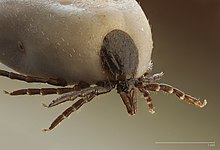Tick
| Tick | |
|---|---|
 |
|
| Ixodes ricinus, a hard tick | |
| Scientific classification | |
| Kingdom: | Animalia |
| Phylum: | Arthropoda |
| Class: | Arachnida |
| Subclass: | Acari |
| Superorder: | Parasitiformes |
| Order: | Metastigmata=Ixodida |
| Superfamily: |
Ixodoidea Leach, 1815 |
| Families | |
|
|
| Diversity | |
| 18 genera, c. 900 species | |
Ticks are small arachnids, part of the order Parasitiformes. Along with mites, they constitute the subclass Acari. Ticks are ectoparasites (external parasites), living by feeding on the blood of mammals, birds, and sometimes reptiles and amphibians. Ticks had evolved by the Cretaceous period, the most common form of fossilisation being immersed in amber. Ticks are widely distributed around the world, especially in warm, humid climates.
Almost all ticks belong to one of two major families, the Ixodidae or hard ticks, which are difficult to crush, and the Argasidae or soft ticks. Adults have ovoid or pear-shaped bodies which become engorged with blood when they feed, and eight legs. As well as having a hard shield on their dorsal surfaces, hard ticks have a beak-like structure at the front containing the mouthparts whereas soft ticks have their mouthparts on the underside of the body. Both families locate a potential host by odour or from changes in the environment.
Ticks have four stages to their lifecycle, namely egg, larva, nymph, and adult. Ixodid ticks have three hosts, taking at least a year to complete their lifecycle. Argasid ticks have up to seven nymphal stages (instars), each one requiring a blood meal. Because of their habit of ingesting blood, ticks are vectors of at least twelve diseases that affect humans and other animals.
Fossilized ticks are known from the Cretaceous onwards, most commonly in amber. They most likely originated in the Cretaceous (65 to 146 million years ago), with most of the evolution and dispersal occurring during the Tertiary (5 to 65 million years ago). The oldest example is an argasid bird tick from Cretaceous New Jersey amber. The younger Baltic and Dominican ambers have also yielded examples which can be placed in living genera.
...
Wikipedia
